All you know is that you have rubbing going on inside your shoes and some painful bumps forming on your feet. What they are exactly— who knows! That’s what you’re here to find out.
Because of all the different conditions associated with foot rubbing out there, we understand why it’s easy to diagnose your exact issue.
In this post, we’re going to break down the core differences between corns and calluses, as well as look at some common foot conditions associated with or mistaken for these dried masses of skin.
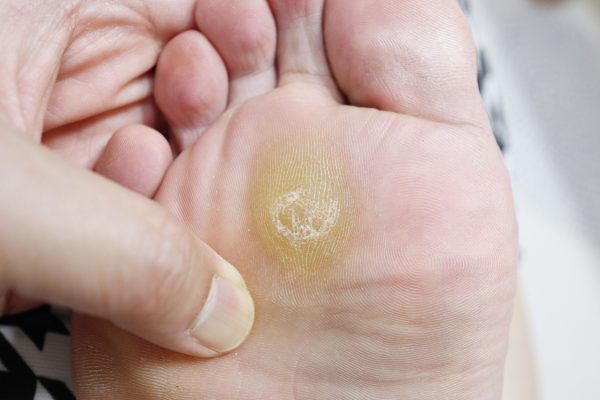
What is a Callus?
We’ve all been for a pedicure and asked if we want to file down the thickened, yellow skin on our heels with a pumice stone or metal file. This hardened, tough skin is often called a callus. But while we commonly see calluses on the heel, they can form on any area of your foot, especially on the pad.
Foot calluses are thicken patches of skin caused by friction, pressure, or irritation that typically form over bony areas of your feet.
Foot Calluses vs. Dry Skin
Foot calluses are sometimes confused with dry, flakey skin on the bottom of the foot, since both often appear pale in color and are associated with rough skin.
Severely dry skin on the bottom of the feet, however, often has noticeably cracked areas, which can be quite painful with or without pressure. Calluses usually do not crack, but instead are thickened, sometimes lumpy layers of dead skin.
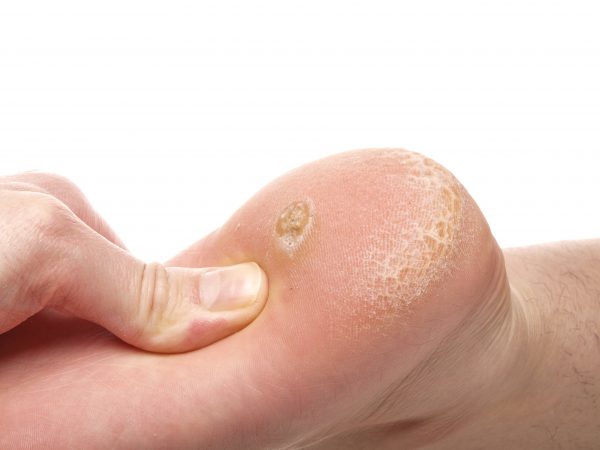
As you can see by the picture, calluses are often yellow in nature due to the buildup of dead skin from friction in the shoe. In addition to their distinct color, another key indicator here is that calluses are thicker than normal dry skin patches.
What is a Corn?
Corns are frequently confused with calluses because they’re both very similar foot conditions.
Think of corns like small, tiny calluses— only they’re about the size of a kernel of corn. Unlike calluses, which form on bony areas of your feet like pads and heels, corns typically form on soft areas of skin, especially seen on the top or sides of your toes.
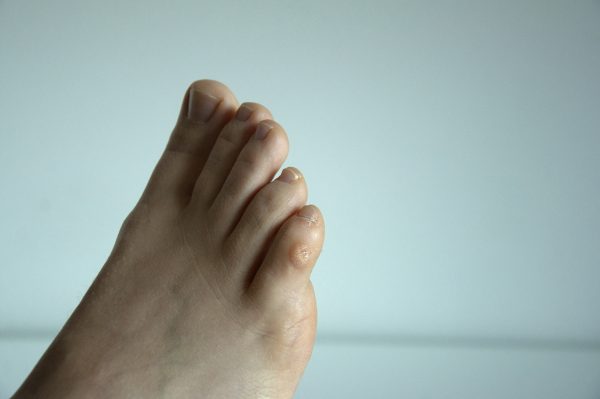
Like calluses, corns are also often the result of friction in your shoes. However, corns are usually never yellow. They’re whitish in color and have a rubbery texture thanks to the thickened, raised masses of skin.
Corns vs. Foot Blisters
Corns and blisters on your feet are both usually caused by rubbing or friction. Because they’re both small, raised bumps, blisters and corns are often confused.
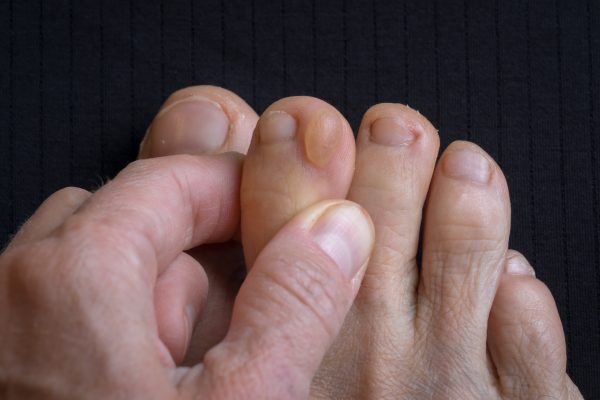
The main difference between the two is that corn lumps are full of dead skin and rubbery in nature, while blisters are often full of fluid and squishy.
Over time, low pressure friction causes the skin to harden and form a corn. But when the sensitive outermost layer of skin, the epidermis, is damaged from excessive, traumatic rubbing, the skin will rub raw and the body will create a sac full of fluid to keep the vulnerable area protected.
Corns vs. Foot Warts
While corns form from friction, a foot wart is a skin lesion that develops as the result of an infection from the human papilloma virus (HPV).
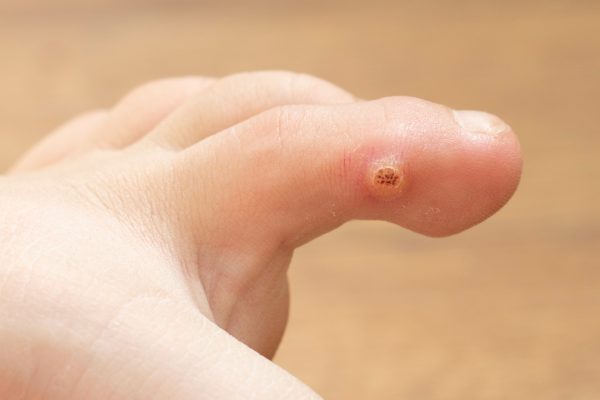
Warts on your toes or the pads of your feet usually have a hardened ridge much like corns. But you can typically differentiate a Plantar wart from a corn by looking for tiny black dots on the raised area. These black pinpoints, AKA “wart seeds,” are actually small, clotted blood vessels.
How Corns & Calluses Affect those with Hammertoes & Bunions
Those with foot deformities like bunions or hammertoes often have trouble finding comfortable footwear as a result of their protruding bone problems.
Because these foot deformities cause parts of the feet to jut out, those with bunions or hammertoes often experience rubbing on these areas— which in turn creates corns or calluses on or around the region of the deformity.
Those with undiagnosed deformities may mistake a corn or callus for their actual condition. For instance, someone with a callus on the side of their big toe may not realize the bunion was the cause, and that the callus is a direct result of the deformity. That’s why it’s very important to see a podiatrist before self-diagnosing your foot issue.
Differentiating Corns, Calluses, Blisters, Warts & Dry Skin
Now that we’ve discussed the core differences between corns and calluses and some other foot problems directly associated with or mistaken for them, here’s a quick recap to help you diagnose which foot issue you’re suffering from:
Callus
- Thickened layers of dead skin caused by friction
- Yellow or white in color
- Often form around the soles of the feet, especially under the heels or balls
- Tenderness under skin when walking
Dry Skin
- Cracked, flakey skin often caused by a lack of moisture
- White in color
- Usually develop around pads of feet, heel, or in between toes
- Bleeding, sensitivity to pressure or touch, and itchy
Corn
- Thickened bumps of dead skin by friction
- White in color, sometimes redness around lump due to irritation
- Usually develop on toes or on the bottoms of the feet
- Tenderness under skin when walking
Blister
- Sac of fluid formed over damaged skin surface
- Match skin tone or red from irritation
- Usually develop on toes or back of heel
- Pain to touch
Plantar Warts
- Skin lesion caused by the human papilloma virus (HPV)
- White in color, usually with black spots
- Usually develop on toes or pads of feet
- Tenderness under skin when walking
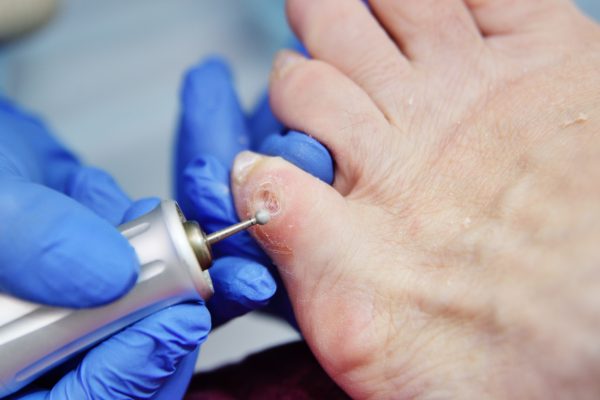
Corn & Callus Removal
As this article clearly shows, corns and calluses are often confused with a number of other foot problems. If you suspect you have a corn or callus or one of the aforementioned conditions, it’s best to have your feet professionally diagnosed.
If you do indeed have corns or calluses, we have specially-designed tools and methods for safe removal and can offer recommendations or footwear adjustments to avoid developing new irritations in the future. In severe cases of bunions or hammertoes, we can get you the corrective surgery you need to never suffer from a painful corn or callus again.
Our team at Foot & Ankle prides ourselves on getting you in quickly. Explore our Corns & Calluses services or call to set up an appointment at 239.936.5400, today.
Categorized in: Blog
Comments are closed